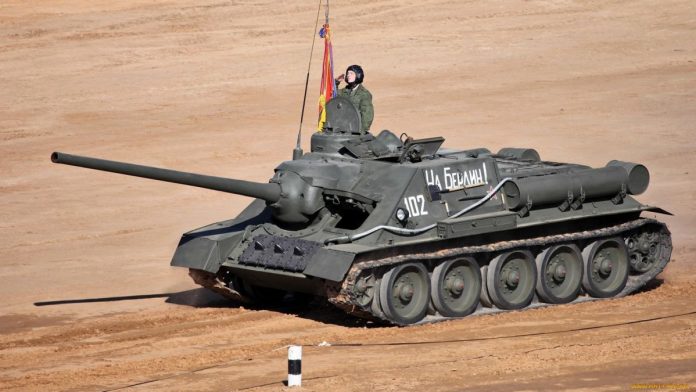
8 August 1943 It was signed the GKO №3892ss "On the organization of production of 85-mm self-propelled gun mounts on the basis of the T-34 at Uralmash". By the beginning of September we were ready early 100 Machines of this type. SU-85 was the most massive Soviet war period average SAU, at the same time at the beginning of production of the machine has been raised about its potential successor. The reason for this was the information from the Kursk Bulge, where the Germans first used medium tanks Pz.Kpfw.Panther Ausf.D and self-propelled Ferdinand. In September 1943 year launched a program of development tools, more powerful, than D-5. The result was the creation of SU-100 - the best of Soviet medium-ACS-war period.
The initiative with the ship ballistics
Work to strengthen the arms of tanks and self-propelled guns went in three directions. first, the easiest direction, It was considered an increase of the initial velocity 85 mm gun to 1000-1050 m / s. The second direction is the use of guns with ballistics 122mm gun body A-19. In the case of heavy tanks, this trend became successful - so there was a gun D-25T, the most powerful of the domestic tank systems. Finally, the third direction is the use of the caliber 100 mm - for the Soviet field artillery and tank this caliber was new.
The story of the Soviet Union guns of this caliber was a difficult. It started with a 100-mm (10-cm) Austro-Hungarian naval gun K10 manufactured by Škoda ("Circular" gauges were typical of the Austro-Hungarian Empire). These instruments were placed including those on ships, that at the end of the First World withdrew Italy. Italians weapon attracted, and the company OTO (Odera Terni Orlando) It has adjusted its production. Italians through 100-mm guns were in the Soviet Union - by using it as a base, Design Bureau of the plant "Bolshevik" has created a first B-24 system, and later the more powerful B-34.
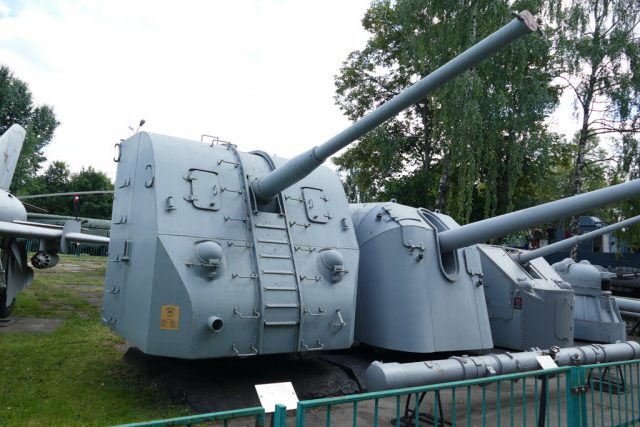
100-korabelnaya mm Installation B-34, exposition of the Central Museum of Armed Forces
B-34 fate was not easy, this tool is not immediately taken advantage of and not once have modified. Nevertheless, he was noticed by engineering offices, engaged in tank systems. The reasons were several.
At first, The gun had a unitary loading, moreover unitary cartridge was rather compact and not too heavy.
Secondly, system is a powerful tool, clearly surpassing the 85-mm anti-aircraft gun and is located approximately in the same category, and that the 107-mm M-60 weapon. true, there was one serious shortcoming: at that time, the B-34 had no armor-piercing projectile. That is why the project "412-1v" Kirov factory, dated January of 1941 of the year, rejected.
About B-34 cannon forgotten for two years, and once again reminded of it in the spring of 1943, the reason for this was the appearance of the front of the German heavy tanks Pz.Kpfw.Tiger Ausf.E.
5 May 1943 , Stalin signed a decree GKO SS №3290 "On the reconstruction of the production of 122-mm guns hull sample 1931-1937 gg. and manufacture of prototypes of lungs hull cannons ". according to him, Development was run "100 mm gun body with ballistics B-34 marine anti-aircraft gun". The most successful was the 100-mm System C-3 Development of the Central Artillery Design Bureau (CAKB), after a year and a half running in the series as the BS-3. This document was preceded by the GKO №3187ss "On measures to strengthen the anti-defense", dated 15 April 1943 of the year, it also discussed the 100-mm gun. Simultaneously with the development of case gun launched projectiles manufactured armor to her, in this way, the issue of this type of ammunition was shot itself.
system selection causes of the ballistics of the B-34 was somewhat:
- At first, nav system was initially unitary loading, which did not manage to get on the 107-mm gun M-60 tank and its version.
- Secondly, B-shell 34 has a high initial velocity - 910 m / s. At the same time, the initial velocity of the projectile ZIS-6 (Tank gun based on the 107-mm M-60 guns) was 865 m / s.
- Thirdly, the difference between the armor-piercing projectiles to B-34 and M-60 was less than two kilograms.
- Fourth, production of the ZIS-6 and M-60 ceased in 1941 year, besides armored version of the M-60 until the end and not finalized. As a result, by autumn 1943 year caliber 107 mm finally disappeared from the promising developments.
Unlike 85mm systems with improved ballistics and 122 mm shells from ballistics A-19, Plant Design Bureau №9 not initially involved in the works on a 100-mm system. Reference for the development of this system in a tank and self-propelled variants instructed TsAKB. Cannon received index P-34, for her work led by the Assistant Chief Designer for the research work of GI. Sergeev.
As with previous tools TsAKB, C-34 system was designed as, allowing the use of guns of various calibers. Initially, the C-34 was a duplex: in addition to the C-34-100, P-34-122 was developed with ballistics 122 mm cannon A-19. Next, add a third system - C-34-85, which had an initial velocity of the projectile 1050 m / s. However, remained priority for C-34-100: December 1943 Year established HF-85 pilot system, and with 22 by 28 in January it experienced Gorokhovets Artillery scientific test proving ground (ANIOP).
The gun was developed and installation option to "on the basis of artsamohod T-34"- here the S-34 revealed the first problems.
At first, According to calculations, the mass of self-propelled guns grew from 30 up to 32.5–33 t, what was unacceptable. To the reliability of the chassis (primarily bandages) and so there were claims, and mass growth would only exacerbate the problem.
Secondly, the TsAKB’s specific approach to the gun created additional difficulties. The thing is, that the shutter wedge did not open to the left, and right, so that charging is on the left, a gunner and a driver - to the right. This was not enough designers TsAKB: project two front road wheels torsion suspension obtained. Not surprising, that the People's Commissariat of the Tank Industry (NKTP) This project panned, and it was necessary to alter.
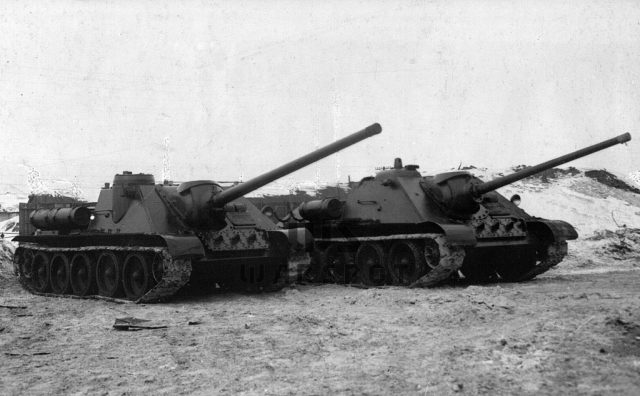
The first prototype SU-100 and SU-serial 85, February 1944 of the year
Intractability TsAKB and very specific attitude Grabin the question "What comes first: tool or framework for it "played in favor of KB plant №9. Initiatively and as soon as possible, headed by F.F.. Petrov, the design team has developed its own caliber system 100 mm. weapon, whose lead designer was M.E.. Bezusov, received the designation D-10. Barrel length was the same 56 calibres (5610 mm), as with S-34-100, the initial velocity of the shells turned out to be the same (900 m / s). true, the rollback length of the D-10T was greater, than a competitor, and was 510–560 mm. Structurally, the system was a logical development of the design of design bureau of plant No. 9, also at its creation maximum unification was achieved. for example, the shutter was taken from D-25, cradle, lifting and swivel mechanisms.
In parallel with the development of caliber artillery systems 100 mm in the design bureau of the Ural Heavy Engineering Plant (UZTM) work was underway to create self-propelled guns for new guns. The development of the machine was led by the same group of designers., as the SU-85, as well as the SU-122. The work was headed by L.I.. Gorlitsky, Leading engineer of the machine was N.V.. Couric.
Largely self-propelled, received the designation SU-100, was the result of compromise decisions. One side, it was obvious, that it is necessary to expand the fighting compartment. On the other hand, designers of the sword of Damocles hanging weight limit. Largely the problem with overloading the chassis were the main cause of, why the same SU-122M and similar machines never became serial. As a result, the fighting compartment in terms of basic geometric parameters remained equivalent to the SU-85. It proved to be identical and the angle of inclination of the upper frontal sheet cuttings - 52 degrees from the vertical.
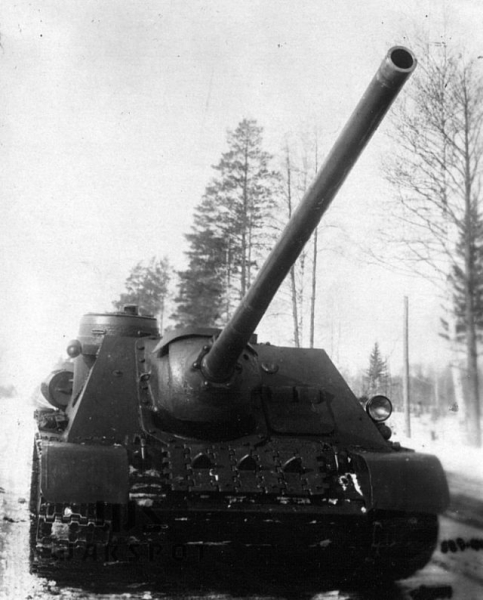
field testing, March 1944 of the year
In fact, the SU-100 was the prototype development of the modernized Su-85, created at the end of 1943 of the year. Compared with the Su-85 was introduced a number of improvements, chief of which was the appearance of the commander's cupola. However, in the development of the SU-100, they were not limited to a simple replacement of tools. To begin with, the thickness of the upper frontal sheet and the driver’s hatch increased to 75 mm. This allowed to significantly increase the resistance of armor against the most common anti-tank guns. (first of all 7,5 cm Pak 40).
Double hatch for the panorama in the roof of the hull has changed, also in his left wing appeared periscope instrument MK-IV. Periscope viewing devices around the cabin, but the exhaust fan returned to the roof. They refused to tilt the feed sheet, which allowed to win a little free space in the fighting compartment.
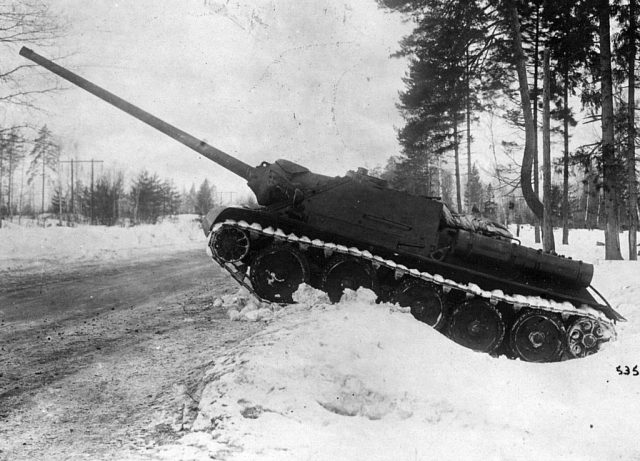
In addition to fire tests, the prototype SU-100 was tested to overcome obstacles. Among other things,, engineers were interested in, how far does the protruding gun barrel
Work on the manufacture of a prototype SU-100 began in February 1944 of the year. NKTP determined the production time of two prototypes 12 February, but in practice they built one car. By the middle of the month, technical documentation for the prototype was prepared. When developing, the priority was the installation of the D-10S system, as for the SU-100 with the S-34 system, that it planned to get the earliest 5 Martha. In the course of designing a combat weight of SU-100, armed system D-10S, calculated at the level of 31-31,5 tons, in the final version of the mass was 31,6 t.
Ammunition compared with the Su-85 has decreased by almost a third - to 33 shots. The overall design of tool setup was similar to the Su-85, wherein the thickness of the movable armor protection system was increased to 150 mm. Also removed from the crew compartment front left fuel tank, and the suspension of the front road wheels reinforced.
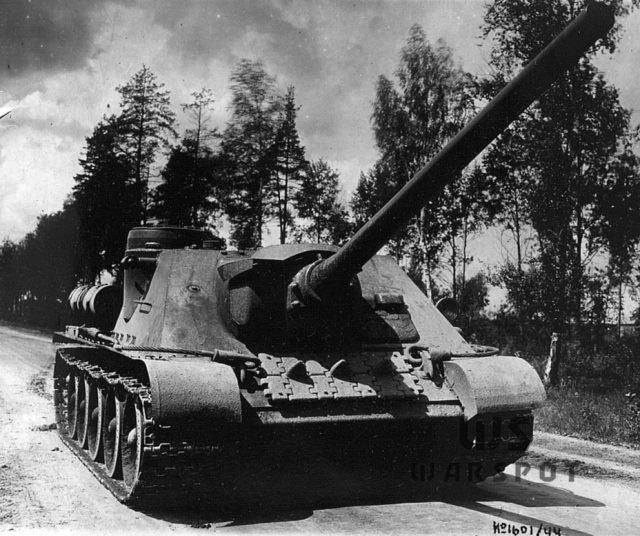
The first prototype of the SU-100, altered under 100mm gun C-34, June 1944 of the year
The first tests of the experimental system A-10C held February 14-15, 1944 of the year, all it has done 108 shots. As for the factory test itself SAU-100, they started towards the end of February. When weighing revealed, that the combat weight is 30 960 kg. the car has passed 100 km at an average speed 24,2 kmh. After the elimination of the small problems the car made up of ground tests, However, the Commission has compiled a list of ten items to improve, in the case of setting the SU-100 in series. In addition, the Commission raised the question of improving the ventilation of the crew compartment.
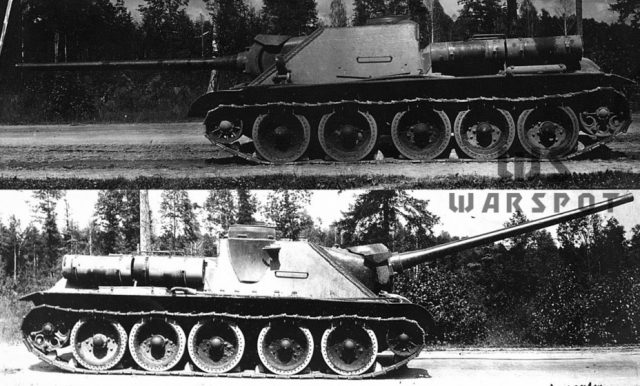
The same machine, side view. In addition to guns, noticeable change was the transfer of the commander's turret ago
Field testing took place at the Gorokhovetsky ANIOP with 9 by 27 Martha. System experienced shooting in volume 1040 shots, of them 517 - enhanced charge. In trials using different groups of packings rate was obtained from 4 to 8 rounds per minute. Also, the installation was 564 km, of them 125 - by continent. In addition, the car has passed more 300 km on the highway and country road (This happened during the shooting test).
Unlike the tank version of D-10, that the test could not stand, situation with a self-propelled version of the system turned out to be much more positive. Despite a number of problems, D-10S withstood firing tests, although the commission made a list of ten points to eliminate. Questions arose not only to the gun: among observations and appeared the proposal to replace the sight 10T-15 telescopic sight on breaking.
There were claims and the crew compartment. commander acknowledged uncomfortable place, required to move the commander's cupola back to 200-250 mm, as well as to alter the seat commander, gunner and loader. Modifying hatches, changed fastening tools for sea and lighting. Repeated claim to the gas content of the crew compartment. Another ten points required changes concerned the self-propelled chassis.
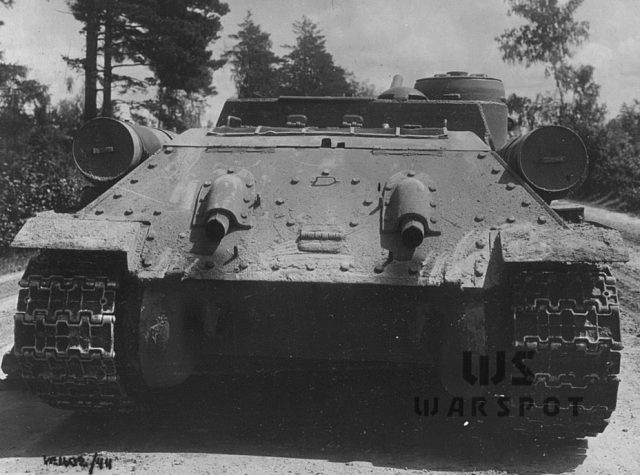
The same machine, back view. The fan on it is not altered, however, against the background of other problems inadequate ventilation of the crew compartment looked sheer trifle
While they were testing the SU-100 to D-10S system, The situation around the C-34 did not develop so fast. In March №92 factory manufactured second and third samples C-34, a 26 the number of them was sent to the plant №100. During the shooting of guns Test №2 (all made 18 shots) found galling crank mechanism axis. Exactly the same defects were found on the gun and №3, from where did 22 shot.
11 May 1944 the People's Commissar for Tank Industry Malyshev subjected to C-34 strongly criticized. According to him, system, intended for in EC-2 and SU-Fitting 100, They were not equipped for the installation of any tank, any SAU. of course, system fine-tuned, but as time went on, and the C-34 still can not be installed in ACS. As much progress as amended was not observed, even on UZTM not particularly in a hurry. The representative TsAKB Guard Captain Boglevsky, arrived at the factory 23 April, reported, that from January to UTZM no activity on this topic was not conducted.
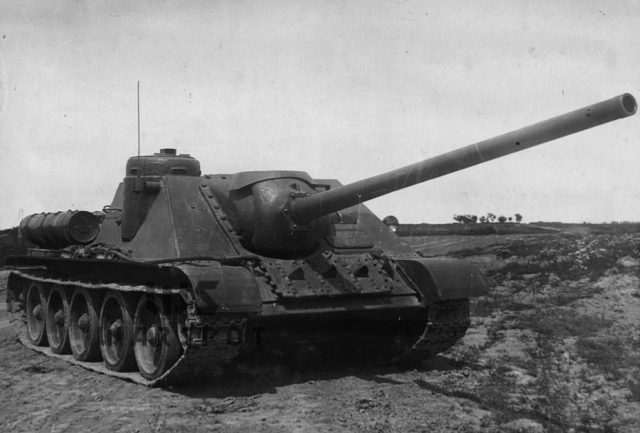
A second sample of SU-100, June 1944 of the year
In fact, work on the production of the SU-100, system equipped with a C-34, It began in June 1944 of the year. Machine built from scratch: The first prototype under TsAKB altered system SU-100. Because, that the gunner was situated to the right, commander's cupola shifted back. Now the loader placed on the left, as a consequence, construction pilings changed. Due to the large, than the D-10S, System size C-34 seats inside the car became less. Besides, of the crew compartment at the Commission appeared even more complaints, than in the first embodiment of SU 100 from D-10C system.
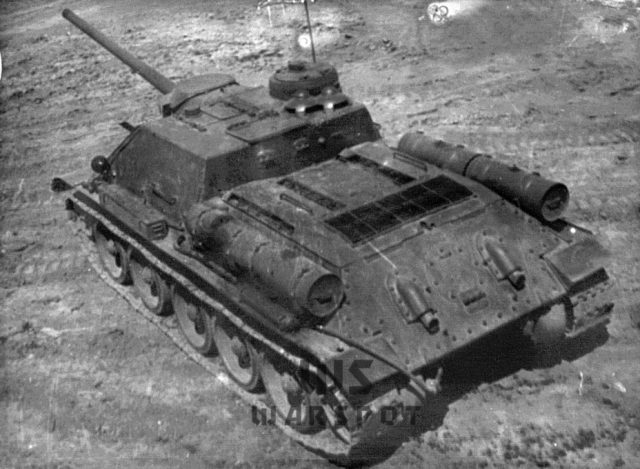
The most notable change was the increase in the number of exhaust fans to two
Tests SU-100 instrument from TsAKB passed on from Gorokhovetsky ANIOP 2 by 7 July 1944 of the year. it was produced 877 shots, of them 511 on enhanced charge. By the shutter, semi-automatic and recoil device had a number of complaints, therefore, a tool recognized not stand the test. There were questions for the crew compartment: for C-34, it turned out to be too small, convenience combat service recognized unsatisfactory.
also found, that of the C-34 is not possible to deliver fire at moving targets. The verdict appeared unequivocal: "Installing gun S-34 self-propelled guns on the base of the tank T-34, due to the small size of the crew compartment SAU, Recommended can not be ".
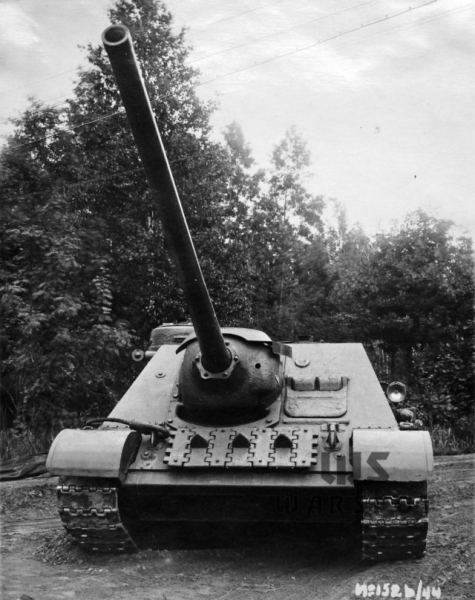
To improve work conditions the commander's cupola moved a little to the right
Quite different was the case with the D-10S. spring 1944 years, this system was considered almost perfect weapons for heavy tanks and self-propelled guns based on T-34. This conclusion was based on the theoretical armor penetration, which gets even slightly higher, than that of D-25. Seriously proposed to rearm to this instrument of the tank IS-2.
true, tests showed, that in fact, the D-10 armor-piercing shell pierced the upper frontal part of the German medium tank Pz.Kpfw.Panther at a distance of 1300-1400 m, and the armor-piercing shell D-25 did the same at a distance of 2–2.5 km. Nevertheless, average SAU D-10C is the optimum system, possessed a high rate of decent and armor penetration data for. It was for a small: modify itself as a weapon, and self-propelled guns for its installation.
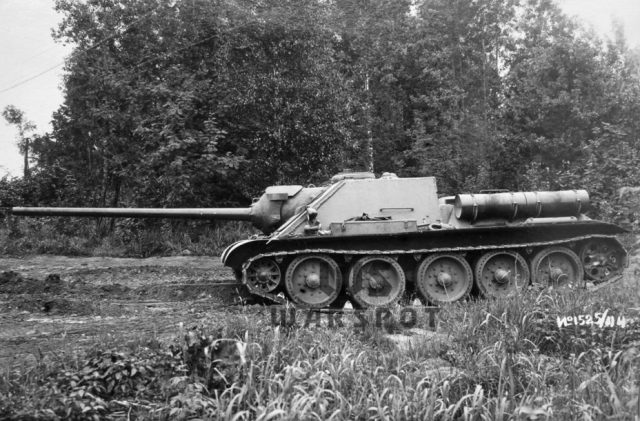
another, a subtle change was an increase in the thickness of the commander’s turret in its frontal part to 90 mm
The second sample of the SU-100 was ready in May 1944 of the year. Already during the construction, the car underwent additional alterations. Besides, that there were two fans on it, they were replaced by more powerful fans MV-12. In connection with this, welds appeared on top of the caps, which on serial machines have turned into characteristic "bells". The commander’s turret was shifted to the right, in view of which the protrusion under it has become larger. The turret itself is no longer symmetrical: in the frontal part, the thickness of the armor increased to 90 mm. Also installed breaking telescopic sight TSh-15, because of which the gun reservation has changed a little.
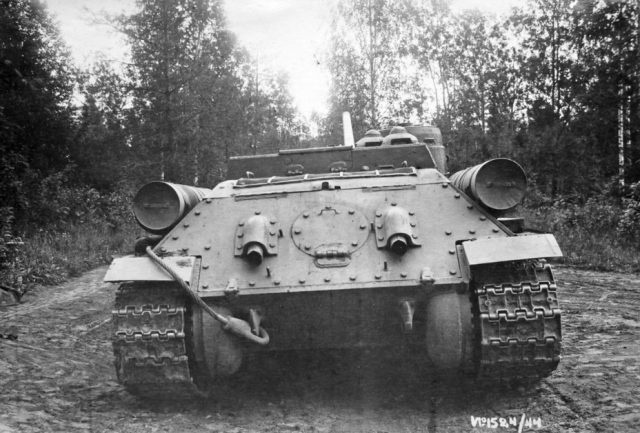
From the stern, the second experimental and serial vehicles of the first releases were identical
Tests of the second prototype SU-100 took place at the Gorokhovetsky ANIOP with 24 by 27 June, during this time the car passed 250 km, of them 50 - with open gun. Also produced 923 shot, of them 526 - enhanced charge. Based on the test results, the commission noted nine correction points for the self-propelled part and twelve for guns and sights.
However, the general verdict was unequivocal: The SU-100 passed the tests and, after refinement, can be adopted by the Red Army. 3 July, Stalin signed the decree of GKO No. 6131ss “On the organization of the production of self-propelled artillery systems SU-100 at the Uralmashzavod of the People’s Commissariat for Tank Industry and 100-mm D-10s guns at plants No. 8 9 People's Commissariat of Arms.
Self-propelled long-lived
The realities of World War II were as follows., that the medium self-propelled guns did not stay long in production. In the case of the SU-100, the situation was reversed: looking ahead, worth mentioning, that this self-propelled gun lasted on the assembly line longer than all Soviet military vehicles developed during the war period. Another thing, that she was not able to get into production right away. The problem was, that with the release of the D-10S system there was some hitch. Knowing this, when signing the decree, GKO gave realistic terms for introducing the machine into the series.
In September 1944 year expected release 40 units, in October - 90, In November - 150, and in December, UZTM completely switched to the SU-100, handing over 210 machines. At the same time, from September to November, a hybrid was produced, known as SU-85M. This machine was a SU-100 chassis and SU-85A weapons. Thanks to such a flexible system for introducing the machine into the series, it was possible to withstand the rates of release established by the decree, and in December also overfulfill the original plan, having surrendered 220 machines (on 10 pieces more). September issue treated in the machine 185 000 rubles, October price dropped to 176 000 rubles.
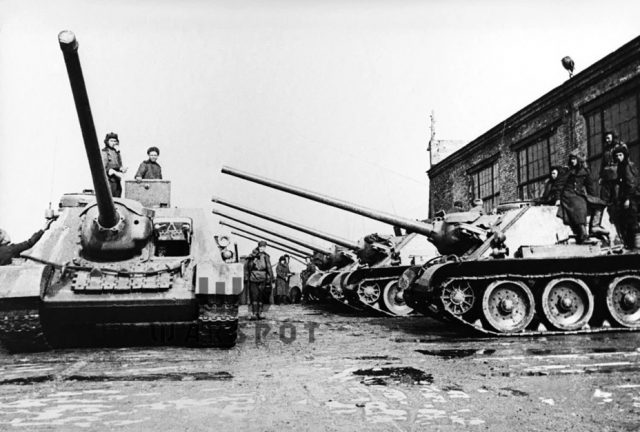
SU-100 serial on site commissioning. UZTM, Spring 1945 of the year
Production models SU-100 were similar in many ways to the second prototype, but with a number of reservations. To begin with, instead of bandages of road wheels with perforation, continuous bandages began to be used., introduced yet at the SU-85 - they showed great survivability. Two smoke bombs began to be mounted on the upper stern sheet of the hull.. Also on the roof of the cabin, to the right of the hatch under the panorama, cap appeared, on which the new gun stop was mounted.
Another noticeable detail appeared on the fixed reservation of the system - characteristic grooves, facilitating the installation of guns on the frontal sheet of the hull. Instead of the TSh-15 sight, a similar TSH-19 sight was placed, it was associated with some problems in the manufacture of the SU-100 in the fall 1944 of the year. When assembling cars of the October release, it was noted 8 cases of overlapping field of view and abutment of the sight into the edge of the embrasure of the frame casing. I had to cut the frame covers, and in November this defect was no longer observed. Finally, there was a characteristic sign in the form of a limiter balancers road wheels, made at a slight slope.
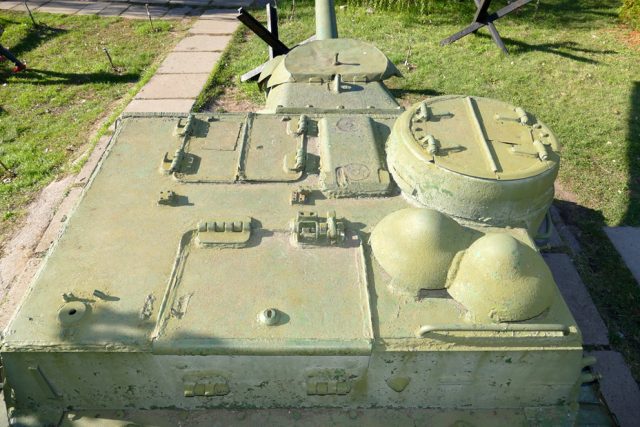
Cabin roof SU-100 September issue 1944 - january 1945 of the year
Initially, the bulk of the defects, observed on the SU-100, gun mount suffered. In the first month of assembly, the frame cover turned out to be the most defective part (17 cases). Similar to problems with the installation of the sight, these defects were fixed on the spot. (in particular, I had to boil the frames of the frame).
There were also problems with mobile bookings and guidance mechanisms.. Complaints about the operation of the lifting mechanism have become quite common, this problem has become so serious, what was going to be a technical meeting about her, dedicated to eliminating problems with the failure of the lifting mechanisms. Similar problems were observed further., for this reason, there is a need to finalize the D-10S (work began in December 1944 of the year).
A much larger “bouquet” of complaints fell on UZTM near the end 1944 of the year, when the cars went to the troops. Complaints about the TSh-19 sights continued, there were cases of detection of cracks in the cabin. However, the largest complaint shaft turned out to be associated with track rollers, more precisely, with their front pair. Despite, that the track rollers reinforced, and also made improvements to the suspension design of the first pair of track rollers, increased wear was observed.
The first pair of track rollers not only destroyed bandages, but there were also cracks in the disks, as well as their welds. This defect turned out to be programmed, similar problems were observed with the German Panzer IV / 70 tank destroyer. Enhanced protection of the frontal part of the hull and a larger gun caused a significant overload of the bow. As a result, in winter and spring 1945 year UZTM had to simultaneously supply new road wheels to parts and develop a reinforced front road wheel and a balancer to it.
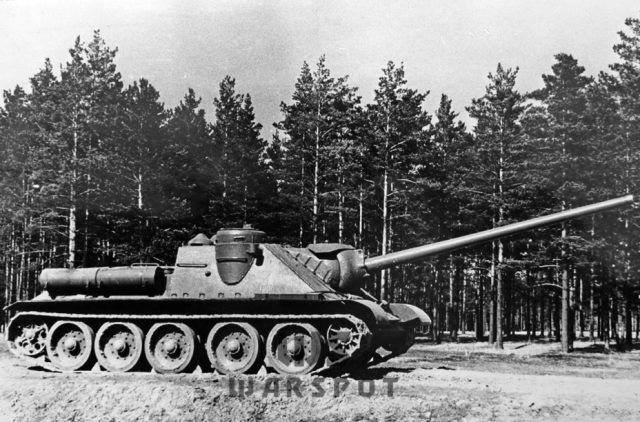
February-April release machine 1945 of the year, during this period, the second hatch door was abandoned
Problems with welds and cracks began to be solved by changing the design of the hull. according to documents, the first such change occurred in January 1945 of the year. Instead of welding the stern of the felling into a thorn-groove, they began to weld it to the sides end-to-end. Since February 1945 of the year canceled the second door of the wheelhouse, although most of the February cars were still equipped with old hatches. Such machines are often called the SU-100 of the second production series., but in fact there were no episodes at all. Around the same time, the spare parts box on the left fender was moved a little back. Finally, the new hulls were put into production in March 1945 of the year, at the same time, the letter "P" disappeared from the driver's hatch (hatch, equal strength with the upper frontal hull sheet 75 mm).
Improvements to the SU-100 continued in April - in particular, tow rope design changed, and instead of 9-PM radio stations they began to put a more advanced 9-RS. Also, from the end of April, the plant switched to the foundation of the engine as plant No. 112. changes, introduced into the construction of hulls, improved their quality. for example, when checking SU-100 hulls in February 1945 year defects were found 5,6%, and in March - 3,2%. true, while there were a lot of defects in gearboxes. The struggle to improve product quality had little effect on output. For january 1945 the plant passed 210 machines, for February - 215, for March - 211, for April - 214. In this way, to 1 May 1945 UZTM passed 1350 SU-100 units.
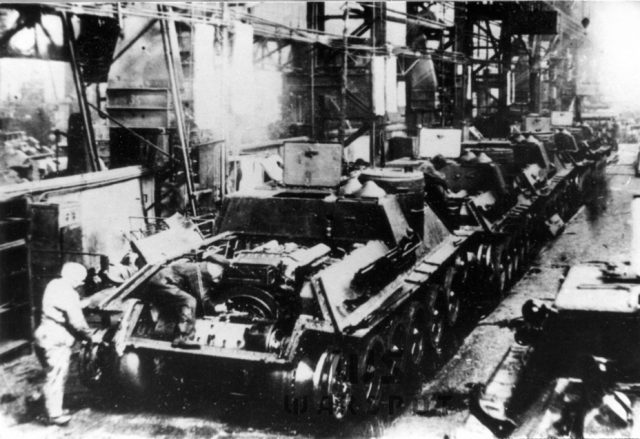
SU-100 release in May-June 1945 of the year. There is no second wing of the conning tower, no "kerchiefs" at the junction of the sides of the cabin and the hull
The end of World War II coincided with a new portion of changes in the design of the SU-100, first of all, her body. FROM 1 May introduced beamless bow of the hull, also eliminate the "headscarf" at the interface boards, and cutting body. Part of the May machines still had the old type of housing, in a similar form, they were produced before the use of the reserve for the hulls. At the same time, the thickness of the lower frontal part of the body increased to 60 mm, and the hinges of the hatches on the roof of the wheelhouse were unified. May became the most “shocking” month in terms of changing the appearance of the SU-100. Then they finally solved the problem of destruction of the front track rollers. In May, they solved the problem with guns: D-10SK was launched into series.
Another external change happened in June: introduced a spare parts box on the right side of the wheelhouse. Other summer changes 1945 years did not look so significant. for example, since July 1945 years there were mounts for self-extracting device.
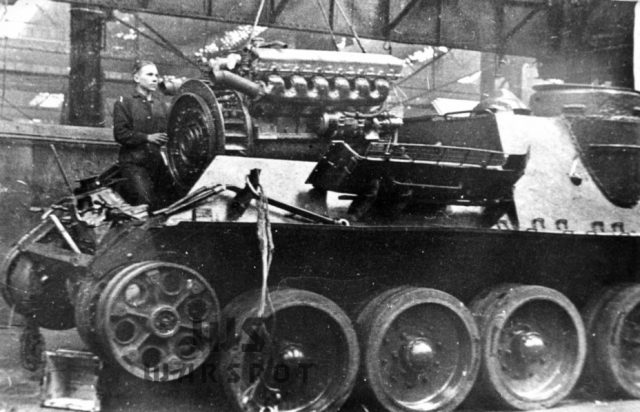
Assembly of the last SU-100 at UZTM
Spring and summer 1945 years, machine production continued at the same level. Passed in May 210 SU-100, the same in June, in July-August - until 200 pcs. The end of World War II significantly reduced the volume of production: already in September 1945 year it dropped to 165 pcs, in October UZTM passed 160 SU-100, In November - 140, and in December - 150. The improvements already had a relatively small volume and finally stopped by December.
Already in November, UZTM knew, that the production of the SU-100 will soon be stopped, the plant gradually switched to the production of civilian products. This significantly influenced the attitude towards the production of the SU-100.. The last SU-100s were delivered to 1946 year: 50 pieces in January, 100 in February, 102 in March. The total production volume was 3037 machines, in this way, SU-100 became the most massive Soviet medium SPG.
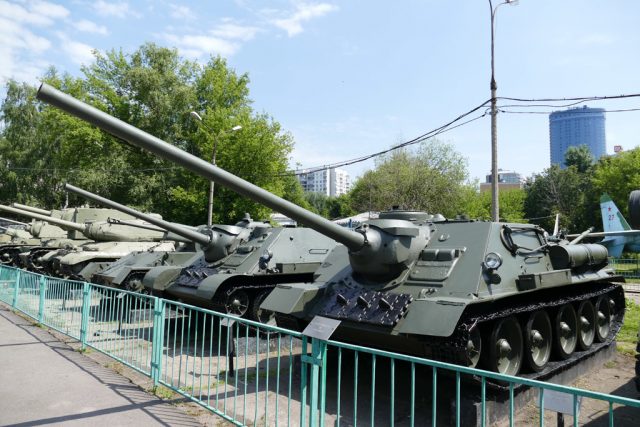
SU-100 manufactured at plant # 174, Omsk. Exposition of the Central Museum of the Armed Forces of the Russian Federation
At this, the production of the SU-100 was suspended., but did not stop. AT 1946 year ended the production of T-34-85 at plant No. 174 in Omsk. anticipated, that the plant will then assemble the T-54, but the car still needed work, this led to a significant shift in the start of its production. To load the plant, it was decided to produce the SU-100 on it. The plan was small: on 1947 year it was only 200 machines. Such small production volumes were explained by the fact, that the SU-100, according to GBTU KA, already out of date, and in fact it supported tank building in Omsk. Only for 1947 year plant No. 174 handed over 194 self-propelled installation, yet 10 pieces delivered to 1948 year, after which work began on the release of the T-54.
Due to the small volume of production, the price of the Omsk SU-100 turned out to be higher and amounted to 303 900 rubles apiece. Externally, the Omsk SU-100 was somewhat different from the Sverdlovsk: their tow hooks looked different, track roller hub covers, commander's turrets, front mudguards and a number of other details. Upper hinge hinges have been unified. Later, many elements of Omsk cars were inherited by the Czechoslovak SD-100.
75-year-old fighter
Organizational shelves, armed with SU-100, had the same structure, as self-propelled artillery regiments (SAP), equipped with SU-85. According to state number 010/462, the regiment had 21 a car (four batteries of five cars in each plus a command vehicle). Since the production of the SU-100 was launched in September 1944 of the year, and the actual delivery to the troops - closer to November, this machine turned out to be much less visible on the battlefield, than the SU-85.
In fact, the combat use of the SU-100 began only at the beginning 1945 of the year. The date of the SU-100's combat debut was also influenced by the revealed defects, first of all, failure of the front track rollers. There were also complaints about various parts of the gun mount., and also cracks, manifested at the junction of the cutting boards and "kerchiefs".
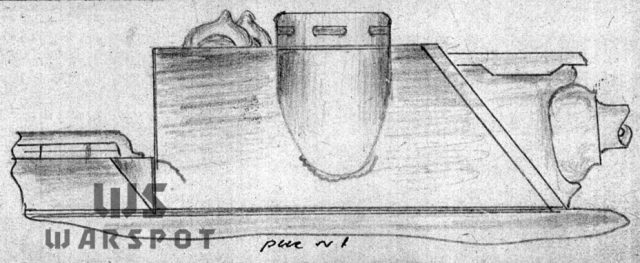
Diagram of a crack in the side of the SU-100 wheelhouse from the report of the 1st Guards Tank Corps. This defect was quite common, which later led to a revision of the cabin design
One of the first SU-100s used SAP, which were part of the 1st Guards Tank Corps. It happened in early January 1945 years during the fighting in Hungary. TO 5 January, the corps included the 1453rd SAP, 1821-y SAP and 382-y GvSAP, armed with new ACS. For the first time, new cars really showed themselves 11 January, when, according to the corps command, the Germans launched a counterattack, supporting the infantry with tanks up to 100 pcs. By the forces of 1453 and 1821 SAP was burned 20 tanks.
In further battles, held on the outskirts of Budapest, SU-100 performed well, but in its report the 1st Corps also pointed out a number of shortcomings (this mainly concerned cracks in the housing and problems with the front road wheels). Self-propelled gunners also complained about the TSh-19 sight - some of the vehicles were produced in September-October 1944 of the year, when the problem with scopes has not been completely solved yet.
During defensive battles, an urgent need for machine-gun armament was revealed. Opinions are divided on this issue.: some of the crews proposed to make a machine gun paired with a gun (like on tanks), others suggested putting it on a turret. Another thing, that the very presence of a machine gun was not even discussed. 8 January 382nd GvSAP lost 10 SU-100 as a result of an attack by enemy infantry, from which there was nothing to fight back. As a result, the regiment lost half of its vehicles., without even engaging in battle with enemy armored vehicles.
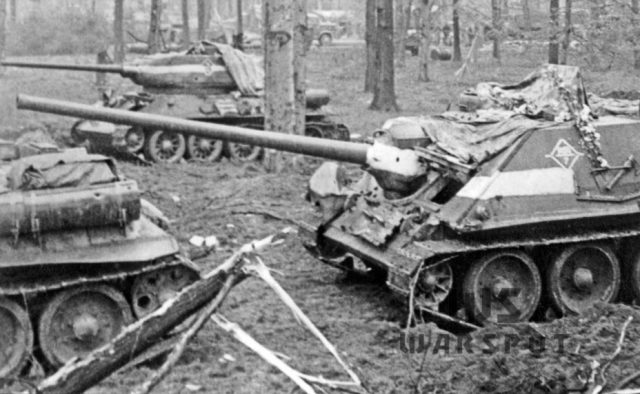
SU-100 on the approaches to Berlin, 30 April 1945 of the year
During the battles for Hungary, the SU-100 was used quite intensively.. So, these vehicles also participated in repelling the German counteroffensive in the area of Lake Balaton. Among the parts, counter-offensive, was the 912th SAP from the 207th self-propelled artillery brigade (former 1st Red Banner Tank Brigade). The regiment went into battle 8 Martha 1945 of the year, a 11 March took up a defensive position in the Kishvelentse area. The next day, the attack of German tanks began.. As a result of the attack, the Germans lost nine tanks and up to 70 soldier killed, and the 912th SAP - two SU-100 burned out and two damaged (two self-propelled gunners were killed, 17 wounded). Such losses sobered up the Germans, up to 18 March 912th position they did not attack SAP.
20 March, the regiment, together with the 34th SD, went on the attack. During the battle with 14 German tanks, self-propelled guns destroyed seven tanks (one of them is Panther) and two Panthers knocked out. In total, during the offensive on March 20–22, the regiment destroyed seven tanks and destroyed two, having lost five SU-100 burned out and one broken (five self-propelled gunners were killed, 26 wounded). This was followed by fighting for the Raba Canal and the city of Sopron. For period 23 by 30 in March self-propelled guns destroyed six more tanks and self-propelled guns, four armored personnel carriers, 14 anti-tank guns and to the infantry battalion. Own losses amounted to one burned down SU-100, three were blown up by a mine, burned armored car BA-10 (six self-propelled gunners died, nine were injured).
912-th SAP fought before 15 April, losing more than a month of fighting 15 SU-100 burned and 1 SU-100 lined (killed 21 and wounded 87 self-propelled gunners). During the fighting, the regiment received a replenishment in the form of five SU-100. The remaining ten vehicles were delivered to the 208th self-propelled artillery brigade. In its turn, 912-th SAP reported 39 destroyed tanks and self-propelled guns, 30 APC and 55 instruments. It was also captured 20 enemy tanks, to 40 tractor, 17 guns and up 500 soldier, including Hungarian.
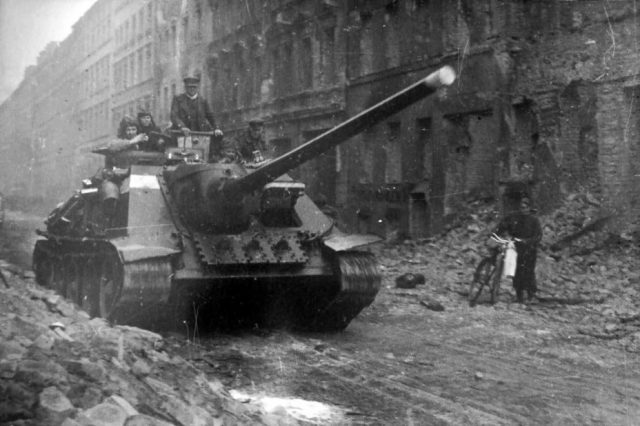
SU-100 in battle on the streets of Berlin
Due to this, what parts, previously armed SU-85, spring 1945 years massively rearmed on the SU-100, by April 1945 years, these machines have already quite actively flashed in the footage of the chronicle. Significant was their contribution to the fighting.. SU-100 played an important role in the battles in Germany, Austria and Czechoslovakia, actively used in battles for Berlin and Vienna. Despite some problems, this vehicle became the best allied medium-class SPG.
Due to the significant strengthening of the frontal part of the wheelhouse, the SU-100 turned out to be much more resistant to German anti-tank artillery fire., especially caliber 75 mm. Closest to the SU-100 was the German tank destroyer Panzer IV / 70 (V), but he was significantly inferior to the Soviet machine in mobility. The SU-100 also turned out to be more powerful, allowing to hit the “Panther” at a distance of over a kilometer. The only tank, which the SU-100 could not hit, was Pz.Kpfw.Tiger Ausf.B ("Royal tiger"), but fewer were released 500 pcs, and to fight this rare "beast" there were more powerful self-propelled guns.
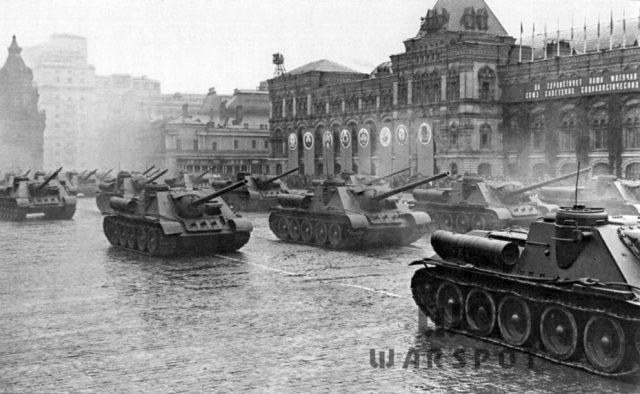
At the Victory Parade. Red Square, 24 June 1945 of the year
The large volume of release and high tactical and technical characteristics of the SU-100 ensured its long life. Despite, that in GBTU KA is still in 1945 year dreamed of a replacement SU-100, this vehicle became the last Soviet medium SPG, produced in such significant volumes. SU-101 (she is Uralmash-1) never went into production, and the SU-122-54 that appeared in the 50s was released in a modest circulation. In addition, it turned out, that for most tasks the D-10S gun is quite enough. As a result, the SU-100 stayed in the Soviet army for a long time., after going through several stages of modernization.
In later years, the SU-100 was used mainly as a training vehicle., it was officially removed from service by the Russian army in 1997 year (together with T-34-85).
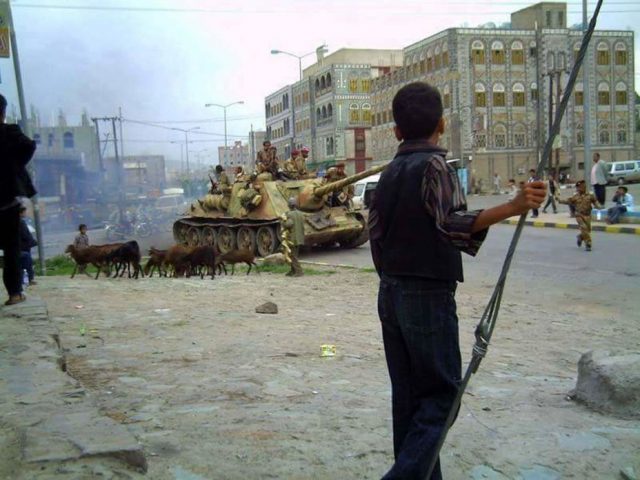
SU-100 in Yemen. These machines are used there as moving firing points.
In large volumes, the SU-100 was delivered abroad: to Poland, Czechoslovakia (there it was also licensed as SD-100), Bulgaria, Yugoslavia, GDR, Romania, Albania, Cuba, China and several other countries. This machine has repeatedly participated in local conflicts., Furthermore, some SU-100 are still fighting (eg, in Yemen). In this way, it is too early to put an end to the combat career of this vehicle.
/Yuri Pasholok, warspot.ru/







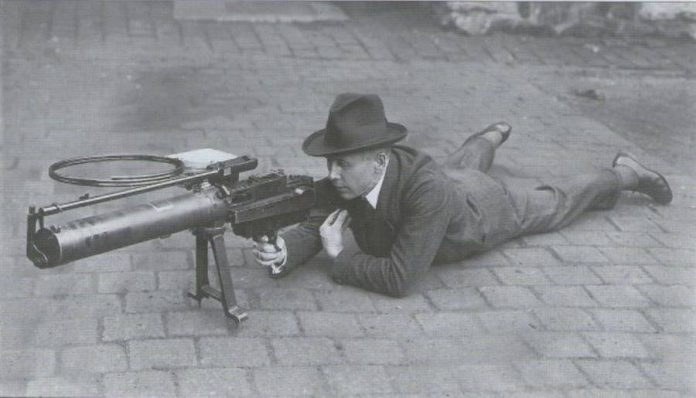



Interesting article. Thank you.